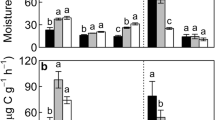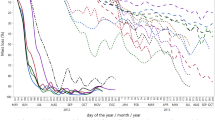Abstract
Background and aims
Dead leaves may remain standing all winter before entering the soil as litter in subtropical forests. However, little is known about the standing decomposition of dead leaves and how this might influence subsequent litter decomposition in the soil.
Methods
We conducted an investigation of the standing decomposition of dead leaves in winter in a subtropical forest. In the following summer, we conducted a decomposition experiment of pre-standing litter (dead leaves picked immediately after leaf death) and post-standing litter (dead leaves picked after winter) in the soil using the litterbag method, further exploring the influences of the standing process on subsequent litter decomposition in the soil.
Results
After 159 days of standing decomposition, up to 43% of leaf mass was lost, with lignin and cellulose degraded by 30% and 35%, respectively. After 163 days of decomposition in the soil, the mass losses of pre-standing and post-standing litter were 31% and 52%, respectively. The decomposition rate (k) of post-standing litter was 2 times that of pre-standing litter. Restrained by the low photodegradability of litter in the later stage of decomposition, standing decomposition still conformed to the exponential decomposition model.
Conclusion
The standing decomposition of dead leaves in winter is driven predominantly by the abiotic process of photodegradation with leaching, resulting in substantial carbon loss in the standing phase and a doubling of the subsequent litter decomposition rate in soil, thus profoundly influencing the carbon process of subtropical forest ecosystems.
Graphical abstract







Similar content being viewed by others
Data availability
The datasets generated during and/or analysed during the current study are available in the Dryad Digital Repository, https://doi.org/10.5061/dryad.2z34tmpqx.
References
Angst Å, Cajthaml T, Angst G, Šimáčková H, Brus J, Frouz J (2017) Retention of dead standing plant biomass (marcescence) increases subsequent litter decomposition in the soil organic layer. Plant Soil 418:571–579. https://doi.org/10.1007/s11104-017-3318-6
Angst Å, Veselá H, Bartuška M, Jílková V, Frouz J, Angst G (2022) Changes in the quality of marcescent and shed senescent leaves during the dormant season. Plant Soil 474:373–382. https://doi.org/10.1007/s11104-022-05341-4
Austin AT, Ballare CL (2010) Dual role of lignin in plant litter decomposition in terrestrial ecosystems. PNAS 107:4618–4622. https://doi.org/10.1073/pnas.0909396107
Austin AT, Vivanco L (2006) Plant litter decomposition in a semi-arid ecosystem controlled by photodegradation. Nature 442:555–558. https://doi.org/10.1038/nature05038
Bani A, Pioli S, Ventura M, Panzacchi P, Borruso L, Tognetti R, Tonon G, Brusetti L (2018) The role of microbial community in the decomposition of leaf litter and deadwood. Appl Soil Ecol 126:75–84. https://doi.org/10.1016/j.apsoil.2018.02.017
Barnes P, Throop H, Archer S, Breshears D, McCulley R, Tobler M (2015) Sunlight and soil–litter mixing: drivers of litter decomposition in drylands. Progress Botany 76:273–302. https://doi.org/10.1007/978-3-319-08807-5_11
Berg B, McClaugherty C (2003) Decomposition as a process. In: Berg B (ed) Plant litter: decomposition, humus formation, carbon sequestration. Springer, Berlin Heidelberg, Berlin, Heidelberg
Berg B, Staaf H (1980) Decomposition rate and chemical changes of Scots pine needle litter. II Influence of chemical composition. Ecol Bull 32:373–390
Bradford MA, Tordoff GM, Eggers T, Jones TH, Newington JE (2002) Microbiota, fauna, and mesh size interactions in litter decomposition. Oikos 99:317–323. https://doi.org/10.1034/j.1600-0706.2002.990212.x
Brandt LA, King JY, Hobbie SE, Milchunas DG, Sinsabaugh RL (2010) The role of photodegradation in surface litter decomposition across a grassland ecosystem precipitation gradient. Ecosystems 13:765–781. https://doi.org/10.1007/s10021-010-9353-2
Chomel M, Fernandez C, Bousquet-Mélou A, Gers C, Monnier Y, Santonja M, Gauquelin T, Gros R, Lecareux C, Baldy V (2014) Secondary metabolites of Pinus halepensis alter decomposer organisms and litter decomposition during afforestation of abandoned agricultural zones. J Ecol 102:411–424. https://doi.org/10.1111/1365-2745.12205
Cogulet A, Blanchet P, Landry V (2016) Wood degradation under UV irradiation: a lignin characterization. J Photochem Photobiol B: Biol 158:184–191. https://doi.org/10.1016/j.jphotobiol.2016.02.030
Day TA, Guenon R, Ruhland CT (2015) Photodegradation of plant litter in the sonoran desert varies by litter type and age. Soil Biol Biochem 89:109–122. https://doi.org/10.1016/j.soilbio.2015.06.029
De Long JR, Dorrepaal E, Kardol P, Nilsson M-C, Teuber LM, Wardle DA (2016) Understory plant functional groups and litter species identity are stronger drivers of litter decomposition than warming along a boreal forest post-fire successional gradient. Soil Biol Biochem 98:159–170. https://doi.org/10.1016/j.soilbio.2016.04.009
De’ath G (2007) Boosted trees for ecological modeling and prediction. Ecology 88:243–251. https://doi.org/10.1890/0012-9658(2007)88
Du J, Zhang Y, Guo W, Li N, Gao C, Cui M, Lin Z, Wei M, Zhang H (2018) Chronic impacts of TiO2 nanoparticles on Populus nigra L. leaf decomposition in freshwater ecosystem. J Hazard Mater 350:121–127. https://doi.org/10.1016/j.jhazmat.2018.02.010
Foereid B, Bellarby J, Meier-Augenstein W, Kemp H (2010) Does light exposure make plant litter more degradable? Plant Soil 333:275–285. https://doi.org/10.1007/s11104-010-0342-1
Frey SD, Elliott ET, Paustian K, Peterson GA (2000) Fungal translocation as a mechanism for soil nitrogen inputs to surface residue decomposition in a no-tillage agroecosystem. Soil Biol Biochem 32:689–698. https://doi.org/10.1016/S0038-0717(99)00205-9
Frouz J, Cajthaml T, Mudrak O (2011) The effect of lignin photodegradation on decomposability of Calamagrostis epigeios grass litter. Biodegradation 22:1247–1254. https://doi.org/10.1007/s10532-011-9479-8
Garcia-Palacios P, Maestre FT, Kattge J, Wall DH (2013) Climate and litter quality differently modulate the effects of soil fauna on litter decomposition across biomes. Ecol Lett 16:1045–1053. https://doi.org/10.1111/ele.12137
Gliksman D, Navon Y, Dumbur R, Haenel S, Grünzweig JM (2018) Higher rates of decomposition in standing vs. surface litter in a Mediterranean ecosystem during the dry and the wet seasons. Plant Soil 428:427–439. https://doi.org/10.1007/s11104-018-3696-4
Guo C, Cornelissen JHC, Zhang Q, Yan E (2019) Functional evenness of N-to-P ratios of evergreen-deciduous mixtures predicts positive non-additive effect on leaf litter decomposition. Plant Soil 436:299–309. https://doi.org/10.1007/s11104-018-03925-7
Huang G, Li Y (2017) Photodegradation effects are related to precipitation amount, precipitation frequency and litter traits in a desert ecosystem. Soil Biol Biochem 115:383–392. https://doi.org/10.1016/j.soilbio.2017.08.034
Jiang H, Pan Y, Liang J, Yang Y, Chen Q, Lv M, Pang L, He W, Tian X (2022) UV radiation doubles microbial degradation of standing litter in a subtropical forest. J Ecol 110:2156–2166. https://doi.org/10.1111/1365-2745.13939
King JY, Brandt LA, Adair EC (2012) Shedding light on plant litter decomposition: advances, implications and new directions in understanding the role of photodegradation. Biogeochemistry 111:57–81. https://doi.org/10.1007/s10533-012-9737-9
Li D, Ju W, Lu D, Zhou Y, Wang H (2015) Impact of estimated solar radiation on gross primary productivity simulation in subtropical plantation in southeast China. Sol Energy 120:175–186. https://doi.org/10.1016/j.solener.2015.07.033
Lin H, He Z, Hao J, Tian K, Jia X, Kong X, Akbar S, Bei Z, Tian X (2017) Effect of N addition on home-field advantage of litter decomposition in subtropical forests. For Ecol Manage 398:216–225. https://doi.org/10.1016/j.foreco.2017.05.015
Lin Y, King JY, Karlen SD, Ralph J (2015) Using 2D NMR spectroscopy to assess effects of UV radiation on cell wall chemistry during litter decomposition. Biogeochemistry 125:427–436. https://doi.org/10.1007/s10533-015-0132-1
Liu R, Pan Y, Fang Y, Pang L, Shen J, Tian X (2021) Effects of heavy metal-mediated intraspecific variation in leaf litter on the feeding preferences of stream detritivores. Sci Total Environ 763:144591. https://doi.org/10.1016/j.scitotenv.2020.144591
Logan JR, Barnes P, Evans SE (2022) Photodegradation of plant litter cuticles enhances microbial decomposition by increasing uptake of non-rainfall moisture. Funct Ecol 36:1727–1738. https://doi.org/10.1111/1365-2435.14053
Manzoni S, Jackson Robert B, Trofymow John A, Porporato A (2008) The global stoichiometry of litter nitrogen mineralization. Science 321:684–686. https://doi.org/10.1126/science.1159792
McKee GA, Soong JL, Caldéron F, Borch T, Cotrufo MF (2016) An integrated spectroscopic and wet chemical approach to investigate grass litter decomposition chemistry. Biogeochemistry 128:107–123. https://doi.org/10.1007/s10533-016-0197-5
Olson JS (1963) Energy storage and the balance of producers and decomposers in ecological systems. Ecology 44:322–331. https://doi.org/10.2307/1932179
Ormeno E, Baldy V, Ballini C, Larcheveque M, Perissol C, Fernandez C (2006) Effects of environmental factors and leaf chemistry on leaf litter colonization by fungi in a Mediterranean shrubland. Pedobiologia 50:1–10. https://doi.org/10.1016/j.pedobi.2005.07.005
Parton W, Silver Whendee L, Burke Ingrid C, Grassens L, Harmon Mark E, Currie William S, King Jennifer Y, Adair EC, Brandt Leslie A, Hart Stephen C, Fasth B (2007) Global-scale similarities in nitrogen release patterns during long-term decomposition. Science 315:361–364. https://doi.org/10.1126/science.1134853
Read J, Sanson GD (2003) Characterizing sclerophylly: the mechanical properties of a diverse range of leaf types. New Phytol 160:81–99. https://doi.org/10.1046/j.1469-8137.2003.00855.x
Santonja M, Foucault Q, Rancon A, Gauquelin T, Fernandez C, Baldy V, Mirleau P (2018) Contrasting responses of bacterial and fungal communities to plant litter diversity in a Mediterranean oak forest. Soil Biol Biochem 125:27–36. https://doi.org/10.1016/j.soilbio.2018.06.020
Vansoest PJ, Robertson JB, Lewis BA (1991) Methods for dietary fiber, neutral detergent fiber, and nonstarch polysaccharides in relation to animal nutrition. J Dairy Sci 74:3583–3597. https://doi.org/10.3168/jds.S0022-0302(91)78551-2
Wang J, Liu L, Wang X, Yang S, Zhang B, Li P, Qiao C, Deng M, Liu W (2017) High night-time humidity and dissolved organic carbon content support rapid decomposition of standing litter in a semi-arid landscape. Funct Ecol 31:1659–1668. https://doi.org/10.1111/1365-2435.12854
Wang C, Lü Y, Wang L, Liu X, Tian X (2013) Insights into seasonal variation of litter decomposition and related soil degradative enzyme activities in subtropical forest in China. J For Res 24:683–689. https://doi.org/10.1007/s11676-013-0405-2
Wardle David A, Bardgett Richard D, Klironomos John N, Setälä H, van der Putten Wim H, Wall Diana H (2004) Ecological linkages between aboveground and belowground biota. Science 304:1629–1633. https://doi.org/10.1126/science.1094875
Xie Y (2020) A meta-analysis of critique of litterbag method used in examining decomposition of leaf litters. J Soils Sed 20:1881–1886. https://doi.org/10.1007/s11368-020-02572-9
Zhai J, Cong L, Yan G, Wu Y, Liu J, Wang Y, Zhang Z, Zhang M (2019) Influence of fungi and bag mesh size on litter decomposition and water quality. Environ Sci Pollut Res 26:18304–18315. https://doi.org/10.1007/s11356-019-04988-4
Zukswert JM, Prescott CE (2017) Relationships among leaf functional traits, litter traits, and mass loss during early phases of leaf litter decomposition in 12 woody plant species. Oecologia 185:305–316. https://doi.org/10.1007/s00442-017-3951-z
Acknowledgements
This work was supported by the National Natural Science Foundation of China (31870598), Priority Research Program of the Chinese Academy of Sciences (A) (XDA19050400), Jiangsu Forestry Science and Technology Innovation and Promotion Project (LYKJ[2021]16), National Key Research and Development Program of the Ministry of Science and Technology of China (2016YFD0600402), State Key Program of National Natural Science Foundation of China (31530007). The author thanks Hao Zhang, Run Liu, Yunchao Luo, and Junbo Yang for their help in the experiment and manuscript revision.
Funding
This work was supported by the National Natural Science Foundation of China (31870598), Priority Research Program of the Chinese Academy of Sciences (A) (XDA19050400), Jiangsu Forestry Science and Technology Innovation and Promotion Project (LYKJ[2021]16), National Key Research and Development Program of the Ministry of Science and Technology of China (2016YFD0600402), State Key Program of National Natural Science Foundation of China (31530007).
Author information
Authors and Affiliations
Contributions
HJ and XT conceived and designed the experiment. HJ, YY and JL collected the data. HJ did statistical analysis and wrote the draft of the manuscript. HJ, ML and XT did the revision. All authors contributed critically to the drafts and gave final approval for publication.
Corresponding author
Ethics declarations
Competing interests
The authors have no conflicts of interest to declare.
Additional information
Responsible Editor: Jonathan Richard De Long.
Publisher’s note
Springer Nature remains neutral with regard to jurisdictional claims in published maps and institutional affiliations.
Supplementary information
Below is the link to the electronic supplementary material.
ESM 1
(DOCX 8.12 MB)
Rights and permissions
Springer Nature or its licensor (e.g. a society or other partner) holds exclusive rights to this article under a publishing agreement with the author(s) or other rightsholder(s); author self-archiving of the accepted manuscript version of this article is solely governed by the terms of such publishing agreement and applicable law.
About this article
Cite this article
Jiang, H., Yang, Y., Liang, J. et al. Standing decomposition of dead leaves in winter and its legacy effects should not be ignored in subtropical forests. Plant Soil 492, 485–499 (2023). https://doi.org/10.1007/s11104-023-06193-2
Received:
Accepted:
Published:
Issue Date:
DOI: https://doi.org/10.1007/s11104-023-06193-2




